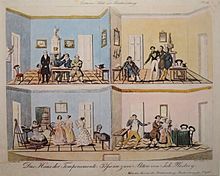Simultaneous stage
The simultaneous stage was a stage form of the mystery plays of the late Middle Ages and remained the predominant stage form outdoors or indoors, such as in the church , until the Renaissance . On a simultaneous stage, all the scenes were next to each other, often at the same time, for example around a market square.
The medieval simultaneous stage expresses, similar to simultaneous representations in the visual arts of the time , a premodern understanding of space and time. Simultaneous actions are not parallel because they take place at the same time, but because they have a comparable value.
history

The carriage stage was a kind of forerunner of the simultaneous stage . The discipline of the theater in the course of the Reformation and Counter-Reformation devalued the improvised stages of the Volkstheater compared to the theater buildings. In parallel to the unity of the place , as demanded by the French Classics of dramas , the simultaneous stage was replaced around 1600 by the succession stage in closed rooms, above all by the baroque backdrop stage . The Shakespeare stage is also still a simultaneous stage in some respects.
The increasing abandonment of baroque stage traditions since the late 18th century gave rise to new concepts for the simultaneous stage. Since the 19th century a “realistic” type of simultaneous stage has emerged in the area of the boulevard theater , for example a decoration with two rooms that are separated by a wall but connected by a door. The actions in these two rooms are strictly simultaneous. A particularly ingeniously constructed simultaneous piece of this kind is Nestroys Zuebener Erde and on the first floor from 1835, in which the two play levels are arranged one above the other.
In the history of theater in the 20th century, there was again a break in strict realism, often in connection with modern media such as film projections. The theater avant-garde of the 1920s made extensive use of the simultaneous stage (e.g. Piscator's premiere of Ernst Toller's Oops, we live!, 1927).
literature
- Erstine, Glenn: The figured memory: Figura, Memoria and simultaneous stage of the German Middle Ages. In: Text and Culture. Medieval Literature, 1150-1450 . 2001, p. 414-437 .
- Jens Roselt: Phenomenology of Theater , Fink, Munich 2008, p. 72ff. ISBN 978-3770546152